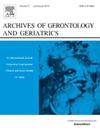Life-course socioeconomic inequalities, social mobility and healthy aging in older adults: A multi-cohort study
IF 3.8
3区 医学
Q2 GERIATRICS & GERONTOLOGY
引用次数: 0
Abstract
Objective
To investigate how socioeconomic positions at different life stages, their relative importance, and social mobility influence IC across the USA, UK, Europe, China, and Japan among adults aged ≥50 years.
Methods
We included 54,217 participants from five nationally representative cohorts in the USA, UK, Europe, China, and Japan. Life-course socioeconomic positions were assessed in early-life (childhood socioeconomic positions), early-adulthood (education), and late-adulthood (household wealth). Healthy aging was measured by intrinsic capacity including cognition, psychological health, locomotion, vitality, and sensory functions. Linear mixed models were used to estimate the associations of intrinsic capacity with each socioeconomic position indicator and social mobility.
Findings
Higher levels of education and wealth were both significantly associated with better intrinsic capacity (p < 0.05 in all cohorts).
Education had a stronger impact on intrinsic capacity than wealth in the USA, Europe, China, and Japan. Middle and high childhood socioeconomic positions were significantly linked to better intrinsic capacity compared with the low group (p < 0.05 in all cohorts). Compared to stable groups, upward and downward social mobility groups were associated with better and worse intrinsic capacity, respectively.
Conclusion
Socioeconomic measures throughout the life course can predict healthy aging in the USA, Europe, and Asia. The long-term negative impact of disadvantaged childhood socioeconomic positions on healthy aging can be partially mitigated by upward mobility later in life. Policies need to narrow the social inequalities from early life and prevent adults from experiencing downward mobility, thereby reducing disparities in healthy aging.
老年人生命历程中的社会经济不平等、社会流动性和健康老龄化:一项多队列研究
目的调查美国、英国、欧洲、中国和日本50岁以上成年人不同人生阶段的社会经济地位及其相对重要性和社会流动性对IC的影响。方法:我们纳入了来自美国、英国、欧洲、中国和日本五个具有全国代表性的队列的54,217名参与者。在生命早期(童年社会经济地位)、成年早期(教育)和成年后期(家庭财富)评估了生命过程中的社会经济地位。健康衰老的内在能力包括认知、心理健康、运动、活力和感觉功能。使用线性混合模型来估计内在能力与各社会经济地位指标和社会流动性的关系。研究发现,较高的教育水平和财富水平都与较好的内在能力显著相关(p <;所有队列0.05)。在美国、欧洲、中国和日本,教育对内在能力的影响比财富更大。与低社会经济地位组相比,中高儿童社会经济地位与更好的内在能力显著相关(p <;所有队列0.05)。与稳定群体相比,向上和向下流动群体的内在能力分别较好和较差。结论在美国、欧洲和亚洲,全生命过程的社会经济指标可以预测健康老龄化。童年时期处于不利地位的社会经济地位对健康老龄化的长期负面影响可以通过以后的向上流动部分缓解。政策需要从生命早期开始缩小社会不平等,防止成年人经历向下流动,从而缩小健康老龄化方面的差距。
本文章由计算机程序翻译,如有差异,请以英文原文为准。
求助全文
约1分钟内获得全文
求助全文
来源期刊
CiteScore
7.30
自引率
5.00%
发文量
198
审稿时长
16 days
期刊介绍:
Archives of Gerontology and Geriatrics provides a medium for the publication of papers from the fields of experimental gerontology and clinical and social geriatrics. The principal aim of the journal is to facilitate the exchange of information between specialists in these three fields of gerontological research. Experimental papers dealing with the basic mechanisms of aging at molecular, cellular, tissue or organ levels will be published.
Clinical papers will be accepted if they provide sufficiently new information or are of fundamental importance for the knowledge of human aging. Purely descriptive clinical papers will be accepted only if the results permit further interpretation. Papers dealing with anti-aging pharmacological preparations in humans are welcome. Papers on the social aspects of geriatrics will be accepted if they are of general interest regarding the epidemiology of aging and the efficiency and working methods of the social organizations for the health care of the elderly.

 求助内容:
求助内容: 应助结果提醒方式:
应助结果提醒方式:


